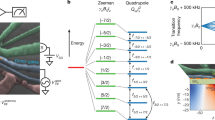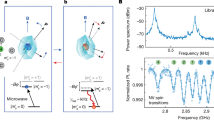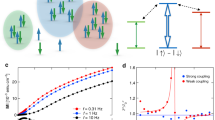Abstract
The nuclear spins in nanostructured semiconductors play a central role in quantum applications1,2,3,4. The nuclear spins represent a useful resource for generating local magnetic5 fields but nuclear spin noise represents a major source of dephasing for spin qubits2,3. Controlling the nuclear spins enhances the resource while suppressing the noise. NMR techniques are challenging: the group III and V isotopes have large spins with widely different gyromagnetic ratios; in strained material there are large atom-dependent quadrupole shifts6; and nanoscale NMR is hard to detect7,8. We report NMR on 100,000 nuclear spins of a quantum dot using chirped radiofrequency pulses. Following polarization, we demonstrate a reversal of the nuclear spin. We can flip the nuclear spin back and forth a hundred times. We demonstrate that chirped NMR is a powerful way of determining the chemical composition, the initial nuclear spin temperatures and quadrupole frequency distributions for all the main isotopes. The key observation is a plateau in the NMR signal as a function of sweep rate: we achieve inversion at the first quantum transition for all isotopes simultaneously. These experiments represent a generic technique for manipulating nanoscale inhomogeneous nuclear spin ensembles and open the way to probe the coherence of such mesoscopic systems.
This is a preview of subscription content, access via your institution
Access options
Subscribe to this journal
Receive 12 print issues and online access
$259.00 per year
only $21.58 per issue
Buy this article
- Purchase on Springer Link
- Instant access to full article PDF
Prices may be subject to local taxes which are calculated during checkout




Similar content being viewed by others
Change history
02 September 2014
In the version of this Letter originally published, the first name of Gunter Wüst was misspelt. This error has now been corrected in the online versions of the Letter.
References
Ribeiro, H. & Burkard, G. Nuclear spins keep coming back. Nature Mater. 12, 469–471 (2013).
Warburton, R. J. Single spins in self-assembled quantum dots. Nature Mater. 12, 483–493 (2013).
Chekhovich, E. A. et al. Nuclear spin effects in semiconductor quantum dots. Nature Mater. 12, 494–504 (2013).
Greilich, A. et al. Nuclei-induced frequency focusing of electron spin coherence. Science 317, 1896–1899 (2007).
Urbaszek, B. et al. Nuclear spin physics in quantum dots: an optical investigation. Rev. Mod. Phys. 85, 79–133 (2013).
Chekhovich, E. et al. Structural analysis of strained quantum dots using nuclear magnetic resonance. Nature Nanotech. 7, 646–650 (2012).
Staudacher, T. et al. Nuclear magnetic resonance spectroscopy on a (5-nanometer)3 sample volume. Science 339, 561–563 (2013).
Mamin, H. J. et al. Nanoscale nuclear magnetic resonance with a nitrogen-vacancy spin sensor. Science 339, 557–560 (2013).
Maletinsky, P., Kroner, M. & Imamoglu, A. Breakdown of the nuclear-spin-temperature approach in quantum-dot demagnetization experiments. Nature Phys. 5, 407–411 (2009).
Latta, C., Srivastava, A. & Imamoglu, A. Hyperfine interaction-dominated dynamics of nuclear spins in self-assembled ingaas quantum dots. Phys. Rev. Lett. 107, 167401 (2011).
Gammon, D. et al. Nuclear spectroscopy in single quantum dots: nanoscopic Raman scattering and nuclear magnetic resonance. Science 277, 85–88 (1997).
Makhonin, M. et al. Fast control of nuclear spin polarization in an optically pumped single quantum dot. Nature Mater. 10, 844–848 (2011).
Flisinski, K. et al. Optically detected magnetic resonance at the quadrupole-split nuclear states in (In,Ga)As/GaAs quantum dots. Phys. Rev. B 82, 081308 (2010).
Cherbunin, R. V. et al. Resonant nuclear spin pumping in (In,Ga)As quantum dots. Phys. Rev. B 84, 041304 (2011).
Bulutay, C. Quadrupolar spectra of nuclear spins in strained InxGa1−xAs quantum dots. Phys. Rev. B 85, 115313 (2012).
Peddibhotla, P. et al. Harnessing nuclear spin polarization fluctuations in a semiconductor nanowire. Nature Phys. 9, 631–635 (2013).
Shevchenko, S., Ashhab, S. & Nori, F. Landau–Zener–Stückelberg interferometry. Phys. Rep. 492, 1–30 (2010).
Poggio, M., Degen, C. L., Rettner, C., Mamin, H. & Rugar, D. Nuclear magnetic resonance force microscopy with a microwire RF source. Appl. Phys. Lett. 90, 263111 (2007).
Kuhlmann, A. V. et al. Charge noise and spin noise in a semiconductor quantum device. Nature Phys. 9, 570–575 (2013).
Kuhlmann, A. V. et al. A dark-field microscope for background-free detection of resonance fluorescence from single semiconductor quantum dots operating in a set-and-forget mode. Rev. Sci. Instrum. 84, 073905 (2013).
Kuhlmann, A. V. et al. Linewidth of single photons from a single quantum dot: key role of nuclear spins. Preprint at http://arXiv.org/abs/1307.7109 (2013).
Latta, C. et al. Confluence of resonant laser excitation and bidirectional quantum-dot nuclear-spin polarization. Nature Phys. 5, 758–763 (2009).
Högele, A. et al. Dynamic nuclear spin polarization in the resonant laser excitation of an InGaAs quantum dot. Phys. Rev. Lett. 108, 197403 (2012).
Vega, S. Fictitious spin 1/2 operator formalism for multiple quantum NMR. J. Chem. Phys. 68, 5518–5527 (1978).
Haase, J., Conradi, M., Grey, C. & Vega, A. Population transfers for NMR of quadrupolar spins in solids. J. Magn. Reson. A 109, 90–97 (1994).
Van Veenendaal, E., Meier, B. H. & Kentgens, A. P. M. Frequency stepped adiabatic passage excitation of half-integer quadrupolar spin systems. Mol. Phys. 93, 195–213 (1998).
Stückelberg, E. Theorie der unelastischen Stössen zwischen Atomen. Helv. Phys. Acta. 5, 369 (1932).
Yoakum, S., Sirko, L. & Koch, P. M. Stueckelberg oscillations in the multiphoton excitation of helium Rydberg atoms: observation with a pulse of coherent field and suppression by additive noise. Phys. Rev. Lett. 69, 1919–1922 (1992).
Oliver, W. D. et al. Mach–Zehnder interferometry in a strongly driven superconducting qubit. Science 310, 1653–1657 (2005).
Huang, P. et al. Landau–Zener–Stückelberg interferometry of a single electronic spin in a noisy environment. Phys. Rev. X 1, 011003 (2011).
Acknowledgements
M.M., G.W., A.V.K., M.P. and R.J.W. acknowledge support from NCCR QSIT and EU ITN S3NANO; M.P. and F.X. from the SNI; and A.L., D.R. and A.D.W. from Mercur Pr-2013-0001 and BMBF-Q.com-H 16KIS0109. The authors thank P. Peddibhotla and C. Kloeffel for technical assistance and C. Degen, P. Maletinsky and H. Ribeiro for discussions.
Author information
Authors and Affiliations
Contributions
M.M. and G.W. carried out the experiments, the data analysis and the theoretical modelling. A.V.K. provided expertise in resonance fluorescence on single quantum dots, and F.X. provided expertise in microwire design and sample processing. F.X. and M.P. provided electronics and software expertise for the NMR. A.L., D.R. and A.D.W. carried out the molecular beam epitaxy. M.M., G.W., M.P. and R.J.W. took the lead in writing the paper and Supplementary Information. R.J.W. conceived and managed the project.
Corresponding author
Ethics declarations
Competing interests
The authors declare no competing financial interests.
Supplementary information
Supplementary information
Supplementary Information (PDF 2273 kb)
Rights and permissions
About this article
Cite this article
Munsch, M., Wüst, G., Kuhlmann, A. et al. Manipulation of the nuclear spin ensemble in a quantum dot with chirped magnetic resonance pulses. Nature Nanotech 9, 671–675 (2014). https://doi.org/10.1038/nnano.2014.175
Received:
Accepted:
Published:
Issue Date:
DOI: https://doi.org/10.1038/nnano.2014.175
This article is cited by
-
Highly indistinguishable and strongly entangled photons from symmetric GaAs quantum dots
Nature Communications (2017)
-
Resonant driving of a single photon emitter embedded in a mechanical oscillator
Nature Communications (2017)
-
Few-second-long correlation times in a quantum dot nuclear spin bath probed by frequency-comb nuclear magnetic resonance spectroscopy
Nature Physics (2016)
-
Quadrupolar and anisotropy effects on dephasing in two-electron spin qubits in GaAs
Nature Communications (2016)
-
Role of the electron spin in determining the coherence of the nuclear spins in a quantum dot
Nature Nanotechnology (2016)



